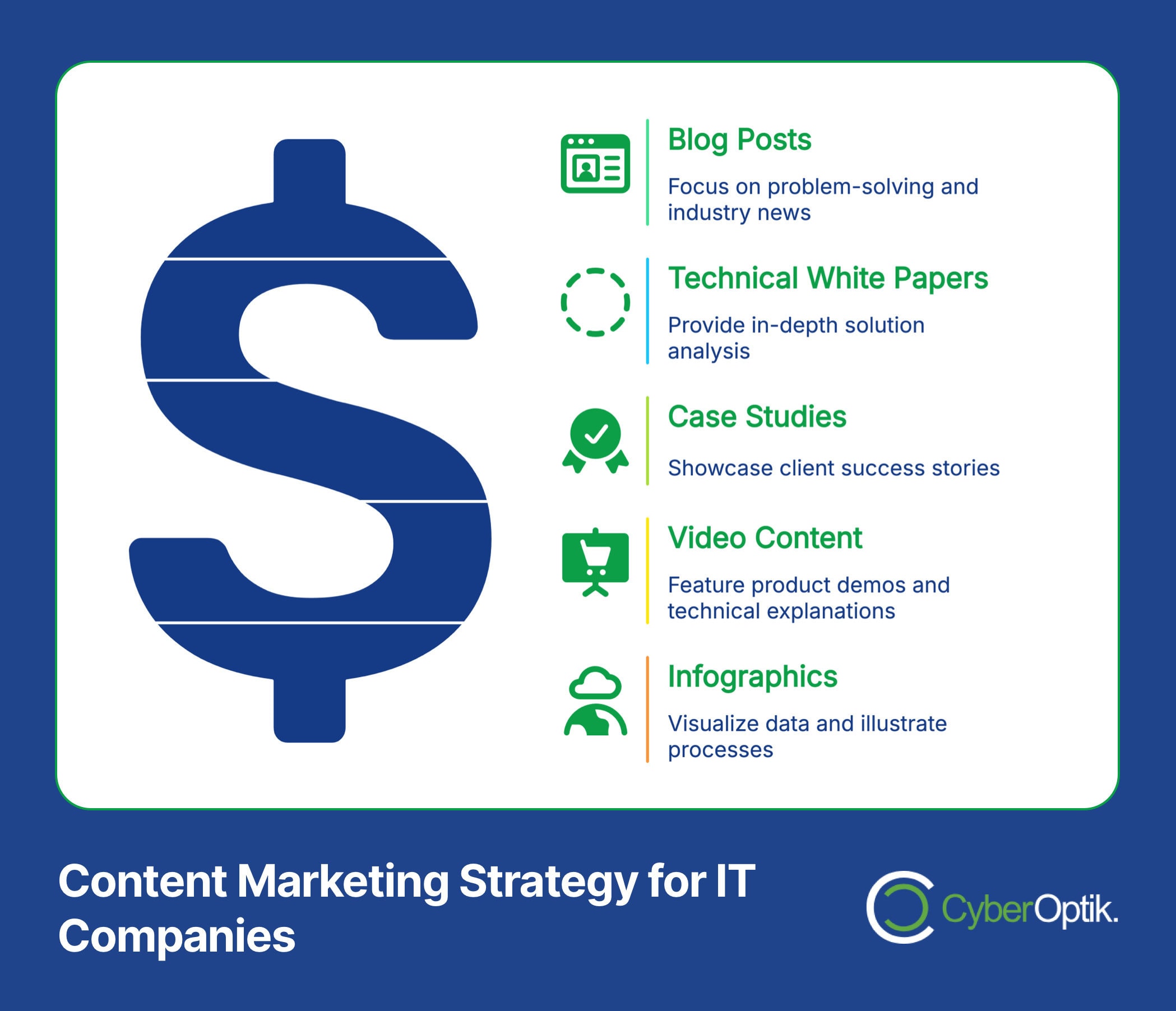Lead generation defines success for IT companies. Without a steady stream of qualified prospects, even the most innovative tech businesses struggle to grow. We’ve seen many IT companies focus too heavily on technical excellence while overlooking strategic marketing approaches that fill their sales pipeline.
The challenge is clear. IT and service companies generate an average of 3,660 leads per month when implementing effective strategies. (Source: Exploding Topics) Yet many technology businesses struggle to capture even a fraction of this potential. The difference often lies in implementing proven, data-driven lead generation strategies specifically tailored to the technology sector.
In this comprehensive guide, we’ll explore the most effective lead generation approaches for IT companies. We’ll cover everything from content marketing and LinkedIn strategies to email automation and webinars. Let’s transform your marketing efforts into a predictable system for generating high-quality IT leads.
Understanding IT Lead Generation
Lead generation for IT companies has unique challenges. Technology purchase decisions typically involve multiple stakeholders, longer sales cycles, and higher price points. This creates a more complex buying journey than in many other industries.
The foundation of successful IT lead generation lies in understanding your ideal client profile. Technology buyers respond to expertise, authority, and demonstrated understanding of their specific challenges. Generic marketing approaches simply don’t convert in this space.
What makes an effective IT lead generation strategy? It combines targeted content that addresses specific pain points, strategic promotion channels where technology decision-makers spend time, and systematic nurturing that builds trust over time. Let’s look at the key components:
- Value-driven content that addresses technical challenges
- Strategic promotion on platforms where IT decision-makers gather
- Effective lead capture mechanisms that balance information gathering with user experience
- Nurturing sequences that build trust and demonstrate expertise
- Conversion optimization that turns interest into qualified sales opportunities
Understanding which channels produce the best results for IT companies helps in allocating your marketing budget effectively. Let’s examine how these channels compare across important metrics:
| Lead Generation Channel | Lead Quality | Cost Efficiency | Time to Results | Best For |
|---|---|---|---|---|
| Content Marketing | High | Medium | 3-6 months | Building authority, SEO |
| LinkedIn Marketing | Very High | Medium-High | 1-3 months | B2B targeting, networking |
| Email Automation | Medium-High | High | 1-2 months | Lead nurturing, retention |
| SEO/Organic Search | High | Medium | 6-12 months | Sustainable traffic, research-phase leads |
| Webinars/Events | Very High | Low-Medium | 1-2 months | Demonstrating expertise, direct engagement |
| PPC Advertising | Medium | Low | Immediate | Quick results, testing messages |
This comparison highlights why most successful IT companies employ multiple channels rather than relying on a single approach. Let’s explore each of these strategies in detail.

Content Marketing: Creating Value that Converts
Content marketing forms the foundation of effective IT lead generation. It works exceptionally well for technology companies because it demonstrates expertise while educating potential clients. Content marketing generates 3x more leads than traditional outbound strategies while costing 62% less. (Source: Sender)

For IT companies, the key is creating content that addresses specific technical challenges your target clients face. This builds credibility and positions your company as a problem solver rather than just another vendor.
When developing a content strategy for IT lead generation, focus on these high-performing formats:
- Technical blog posts that solve specific problems
- White papers and in-depth guides on emerging technologies
- Case studies demonstrating measurable client results
- Technical comparisons between competing solutions
- Video tutorials and demonstrations of complex concepts
Regular blogging deserves special attention in your content strategy. B2B companies that maintain active blogs generate 67% more leads than those without blogs. (Source: Sender) For IT companies, blogs serve as the perfect platform to demonstrate technical knowledge while improving search visibility.
Developing a strategic content calendar ensures you’re consistently publishing valuable material that supports your lead generation goals. Here’s a sample content planning approach specifically for IT companies:
| Content Type | Topic Focus | Publishing Frequency | Lead Capture Mechanism |
|---|---|---|---|
| Blog Posts | Problem-solving, industry news, how-to guides | Weekly | Related resource downloads, newsletter signup |
| Technical White Papers | In-depth solution analysis, technology explanations | Monthly | Gated download requiring contact information |
| Case Studies | Client success stories with measurable results | Bi-monthly | Similar solution inquiry form |
| Video Content | Product demos, technical explanations, interviews | Bi-weekly | CTA to schedule consultation |
| Infographics | Data visualization, process illustrations | Monthly | Social sharing with website link |
The most successful IT content marketing strategies connect each piece of content to specific stages in the buyer’s journey. This ensures you’re capturing leads whether they’re just beginning to research a problem or are ready to evaluate specific solutions.
Email Marketing & Automation for IT Lead Generation
Email remains one of the most powerful channels for IT lead generation and nurturing. Its effectiveness stems from direct access to prospects’ inboxes and the ability to deliver highly personalized content. In fact, 89% of marketers consider email their primary channel for lead generation. (Source: SalesHandy)
For IT companies, email marketing serves two critical functions: converting website visitors into leads and nurturing those leads until they’re sales-ready. The key to success lies in automation – creating targeted sequences that deliver the right content at the right time.
Implementing marketing automation dramatically improves results. Companies using email automation see 80% more leads and a 77% increase in conversions. (Source: Adam Connell) This is particularly valuable for IT companies with complex sales cycles that require multiple touchpoints.
When developing email automation for IT lead generation, focus on creating targeted workflows based on prospect actions and interests. Here are the most effective email sequences for technology companies:
| Automation Workflow | Trigger Event | Number of Emails | Primary Goal |
|---|---|---|---|
| Welcome Sequence | New subscriber/lead form submission | 3-5 emails | Build relationship, set expectations |
| Lead Magnet Follow-up | Technical resource download | 4-6 emails | Provide additional value, introduce solutions |
| Solution Education | Product/service page visits | 5-7 emails | Explain benefits, overcome objections |
| Engagement Recovery | Inactivity for 30+ days | 3 emails | Re-engage dormant prospects |
| Post-Demo Nurturing | Completed product demonstration | 4-5 emails | Address questions, facilitate decision |
The effectiveness of these automation sequences depends on personalization and relevance. 91% of marketers believe automation is critical for nurturing leads through personalized experiences. (Source: Sopro) This means going beyond basic name personalization to deliver content based on a prospect’s industry, challenges, and behavior.
To maximize engagement with your email campaigns, follow these best practices specifically for IT marketing:
First, segment your email list based on prospect characteristics and behaviors. Tech decision-makers respond best to content that directly addresses their specific challenges.
Next, focus on educational content rather than promotional messages. Technical buyers value expertise over sales pitches. Also be sure to include clear, value-focused calls to action in every email. Make the next step obvious and beneficial to the recipient.
Email marketing effectiveness depends heavily on deliverability and engagement metrics. Regularly monitor your open rates, click-through rates, and conversion rates to identify opportunities for improvement. Test different subject lines, content formats, and sending times to optimize performance over time.
LinkedIn & Social Media Strategies for Tech Companies
LinkedIn stands out as the premier social platform for B2B technology marketing. Its business focus and targeting capabilities make it uniquely effective for IT lead generation. An impressive 89% of B2B marketers use LinkedIn for lead generation, higher than any other social platform. (Source: Blue Atlas Marketing)
The platform’s effectiveness stems from its concentration of business decision-makers and its robust targeting options. For IT companies, LinkedIn provides access to technical buyers across industries who are actively seeking solutions and industry insights.
LinkedIn’s advantage over other social platforms is clear in the numbers. LinkedIn ads account for 33% of B2B purchase intent, making it significantly more effective than alternatives for driving actual buying decisions. (Source: Blue Atlas Marketing)
To leverage LinkedIn effectively for IT lead generation, optimize both your company page and personal profiles. These serve as the foundation for all your LinkedIn marketing efforts:
Start with a complete, keyword-rich company profile that clearly communicates your IT expertise and value proposition. Use technical terms your target clients would search for. Encourage your team members to optimize their personal profiles, highlighting their technical expertise and thought leadership. How can you create the best LinkedIn profile that attracts IT clients? Focus on demonstrating specific technical expertise and results rather than generic descriptions. Also regularly share valuable content that addresses specific challenges in your target industries. Establish your company as a trusted resource, not just a vendor.
While organic LinkedIn activity builds your reputation over time, paid LinkedIn campaigns can accelerate lead generation. The platform offers several ad formats particularly effective for IT companies:
| LinkedIn Ad Format | Best Use Case | Lead Generation Effectiveness | Targeting Options |
|---|---|---|---|
| Sponsored Content | Promoting technical articles, case studies | High | Job title, skills, company size, industry |
| InMail Campaigns | Direct outreach to decision-makers | Very High | Precise individual targeting |
| Lead Gen Forms | Webinar registrations, white paper downloads | Very High | Pre-filled forms using LinkedIn data |
| Text Ads | Brand awareness campaigns | Low-Medium | Basic demographic targeting |
| Video Ads | Product demonstrations, explanations | Medium-High | Job function, seniority, skills |
Beyond LinkedIn, a multi-channel social media approach can enhance your IT lead generation efforts. Campaigns that leverage multiple channels achieve a 31% lower cost per lead than single-channel efforts. (Source: Sopro)
For most IT companies, a strategic approach to social media combines LinkedIn as the primary channel with selective activity on other platforms based on where your specific audience spends time. Focus on quality engagement rather than trying to maintain a presence on every platform.
SEO & Organic Strategies for Long-Term Success
Search engine optimization (SEO) delivers some of the highest quality leads for IT companies. These prospects are actively searching for solutions to problems your company can solve. Organic search drives approximately 27% of all website leads across industries. (Source: Databox)
For IT companies, SEO is particularly valuable because technical buyers typically conduct extensive research before contacting potential vendors. By ranking for relevant search terms, you insert your company into the consideration process at the critical research stage.
While SEO generates high-quality leads, it’s important to note that IT companies face higher acquisition costs than many other industries. IT organic leads cost approximately $385 per lead, among the highest of any sector. (Source: SalesHandy) This reflects both the competitive nature of technical keywords and the high value of these prospects.
Developing an SEO strategy for IT lead generation requires a focus on both technical excellence and content relevance. You need a website that performs flawlessly while delivering exactly what searchers want to find.
For maximum lead generation impact, focus your SEO efforts on these key areas:
First, conduct thorough keyword research targeting terms your specific IT clients search for. Go beyond generic terms to find technical keywords with clearer purchase intent.
Next, create in-depth content that demonstrates your expertise on these topics. Technical buyers value substantive, accurate information. Also optimize your website’s technical performance, particularly page speed and mobile responsiveness. Technical factors significantly impact both rankings and user experience.
Additionally, build a strong link profile through industry partnerships, guest posting, and valuable content that naturally attracts backlinks. Search engines view quality backlinks as votes of confidence. Finally, optimize your local SEO if you target clients in specific geographic areas. Many IT purchases still happen within regional business communities.
When evaluating your SEO performance, focus on metrics that directly relate to lead generation rather than just traffic numbers. The most valuable metrics include:
| SEO Metric | What It Measures | Why It Matters for Lead Generation |
|---|---|---|
| Organic Conversion Rate | Percentage of organic visitors who convert to leads | Indicates relevance of traffic and effectiveness of conversion paths |
| Keyword Rankings for Commercial Terms | Position in search for terms indicating purchase intent | Shows visibility to prospects closer to buying decisions |
| Organic Traffic to Solution Pages | Number of search visitors to service/product pages | Reflects ability to attract visitors with specific needs |
| Branded Search Volume | Number of searches for your company name | Indicates growing brand awareness and interest |
| Backlink Quality | Authority and relevance of sites linking to you | Improves rankings and reflects industry credibility |
SEO success requires patience and consistency. While it typically takes 6-12 months to see significant results, the quality of leads and sustainable nature of the traffic make it one of the most valuable long-term investments for IT lead generation.
Webinars & Virtual Events: Showcasing Technical Expertise
Webinars and virtual events provide unique opportunities for IT companies to demonstrate technical expertise while generating highly qualified leads. These formats allow for in-depth exploration of complex topics and direct engagement with potential clients. Data shows that 76% of B2B buyers attend webinars to help inform purchase decisions. (Source: Sender)
For technology companies, webinars serve multiple purposes in the lead generation process. They attract new prospects, nurture existing leads, establish thought leadership, and create opportunities for direct interaction with potential clients.
The effectiveness of webinars for IT lead generation comes from their ability to showcase your expertise on specific technical topics. Participants get a preview of what working with your company would be like, building trust and credibility in a way that static content cannot match.
When planning webinars for IT lead generation, focus on topics that address specific pain points or demonstrate clear solutions to technical challenges. The most effective formats include:
Choose technical deep dives that explore solutions to specific industry challenges in detail. Create solution demonstrations that show your technology in action solving real problems. Develop educational sessions that help prospects understand complex technologies or methodologies. Host panel discussions featuring industry experts discussing emerging trends or challenges. Produce Q&A sessions addressing common questions and concerns in your specialty area.
Promoting your webinar effectively is crucial for attracting the right attendees. Use a multi-channel approach that leverages both your existing audience and new prospect pools:
| Promotion Channel | Best Practices | Timing | Target Audience |
|---|---|---|---|
| Email Marketing | Segment invitations based on topic relevance | Initial announcement 3 weeks prior, reminders at 1 week and 1 day | Existing contacts and leads |
| Use both organic posts and sponsored content | Begin 2 weeks prior, increase frequency as date approaches | Industry professionals matching your target profile | |
| Website | Feature prominently on homepage and blog | Continuous from announcement through event | Website visitors and blog readers |
| Partner Networks | Co-promote with complementary service providers | 2 weeks prior with shared promotion plan | Extended networks beyond your direct contacts |
| Industry Groups | Share in relevant communities (with permission) | 10-14 days prior, reminder 2-3 days before | Specialized technical audiences |
The webinar itself is just the beginning of the lead generation process. The follow-up strategy often determines how many attendees convert to qualified leads. Implement these post-webinar best practices:
Send the recording promptly to all registrants, not just attendees. This captures value from those who couldn’t attend live. Segment your follow-up based on attendance and engagement levels. Create different messages for active participants versus those who registered but didn’t attend. Follow up with personalized outreach to highly engaged participants who asked questions or showed specific interest. Track which topics generate the most engagement and conversion to refine your future webinar strategy.
With the rise of virtual event fatigue, interactive content elements are becoming increasingly important. Interactive elements in webinars boost engagement and conversion rates by approximately 30%. (Source: CallPage)
Converting and Nurturing IT Leads
Generating leads is only half the battle for IT companies. Converting those leads into sales opportunities requires strategic nurturing and effective conversion rate optimization. This is especially important in technology sales, where 44% of sales teams cite poor lead quality as their primary challenge. (Source: Exploding Topics)
The gap between marketing-qualified leads (MQLs) and sales-qualified leads (SQLs) represents one of the biggest challenges for IT companies. Effective lead nurturing bridges this gap by systematically moving prospects through the qualification process.
The impact of proper lead nurturing is substantial. Nurtured leads produce 50% more sales-ready leads at 33% lower cost. (Source: Sopro) For IT companies with complex sales processes, this represents a significant competitive advantage.
Developing an effective lead nurturing strategy for technology sales requires understanding the specific stages of your buyers’ journey. Map content and touchpoints to each stage:
| Buyer's Stage | Lead Nurturing Approach | Content Types | Conversion Goal |
|---|---|---|---|
| Awareness | Educational content about industry challenges | Blog posts, infographics, industry reports | Newsletter subscription, resource download |
| Consideration | Solution-focused content showing approaches | Comparison guides, webinars, case studies | Webinar registration, detailed solution guide download |
| Decision | Vendor-specific information and validation | Product demos, technical specifications, client testimonials | Consultation request, product demonstration |
| Implementation | Practical guidance and support information | Implementation guides, FAQs, onboarding materials | Purchase decision, service agreement |
| Loyalty | Ongoing value and relationship building | Advanced tips, exclusive content, early access | Expansion, referrals, testimonials |
One of the most effective approaches for IT lead conversion is implementing a lead scoring system. This helps prioritize follow-up based on both explicit information (title, company size, industry) and implicit behaviors (content engagement, website activity). With proper lead scoring, companies can improve conversion rates by focusing sales efforts on the most qualified prospects.
Measuring Success: Key Lead Generation Metrics
Effective measurement is essential for optimizing IT lead generation performance. Without clear metrics, it’s impossible to identify what’s working and what needs improvement. The average company generates about 312 sales opportunities per month, but the quality of these opportunities varies dramatically based on lead generation approach. (Source: SalesHandy)
For IT companies, tracking both quantity and quality metrics provides a complete picture of lead generation effectiveness. Focus on these key performance indicators:
| Metric Category | Specific KPIs | Why It Matters | Improvement Strategies |
|---|---|---|---|
| Volume Metrics | Number of leads, lead growth rate, leads by channel | Indicates overall program effectiveness and channel performance | Expand top-performing channels, test new audiences |
| Quality Metrics | Lead-to-opportunity ratio, lead score distribution, sales acceptance rate | Measures how well leads match your ideal customer profile | Refine targeting criteria, improve qualification processes |
| Conversion Metrics | Conversion rate by channel, landing page conversion rates, form completion rates | Shows effectiveness of converting visitors to leads | A/B testing, form optimization, CTA improvements |
| Velocity Metrics | Time to conversion, sales cycle length, nurturing progression rate | Indicates efficiency of moving leads through the funnel | Improve nurturing sequences, address common objections earlier |
| ROI Metrics | Cost per lead, cost per opportunity, customer acquisition cost, lifetime value ratio | Measures financial effectiveness of lead generation | Optimize underperforming channels, focus on high-value segments |
When analyzing these metrics, segmentation provides crucial insights. Break down your data by lead source, industry, company size, and other relevant factors to identify your most valuable prospect segments.
Beyond traditional metrics, technology companies should also track engagement indicators that predict future conversion potential:
Monitor content engagement patterns that show which topics resonate with different audience segments. Track technical resource downloads to identify specific interests and pain points. Record webinar participation and engagement to measure interest in specific solutions or approaches. Also note website behavior patterns, especially time spent on product/service pages and return visit frequency.
Many IT companies are now leveraging advanced analytics and AI to improve lead quality prediction. Approximately 49% of tech marketers are implementing AI strategies to better identify high-potential leads based on behavioral patterns. (Source: Sopro)
The most valuable measurement approach combines leading indicators (early engagement metrics) with lagging indicators (conversion and revenue metrics) to provide a complete picture of lead generation performance. This allows for both tactical adjustments and strategic refinements to your IT lead generation approach.
Implementing an Integrated Lead Generation Strategy
The most successful IT lead generation programs combine multiple channels and tactics into an integrated strategy. This comprehensive approach delivers better results than isolated efforts. We’ve seen that multidimensional campaigns consistently outperform single-channel approaches for our technology clients.
An integrated strategy allows you to leverage the strengths of different channels while minimizing their individual weaknesses. For example, content marketing builds long-term authority while paid advertising delivers immediate visibility. Together, they create a more powerful lead generation system than either could achieve alone.
When developing an integrated lead generation strategy for your IT company, follow these implementation principles:
First, start with a clear definition of your ideal client profile and buyer personas. All channels should target the same well-defined audience. Align your messaging across all channels while adapting the format for each platform’s unique characteristics. Create a consistent experience as prospects move between channels. Implement cross-channel tracking to understand the complete customer journey rather than viewing each channel in isolation. Finally, develop a flexible resource allocation model that allows you to shift investment toward the most effective channels as you gather performance data.
A common challenge in implementing integrated lead generation is maintaining consistency while adapting to each channel’s unique requirements. Create a core messaging document that defines your key value propositions, then adapt the presentation for each platform while maintaining the essential message.
For IT companies specifically, consider this phased implementation approach:
Phase 1: Build your foundation with a high-performing website designed specifically for IT lead generation, basic content assets, and lead capture mechanisms.
Phase 2: Expand your reach through SEO optimization, LinkedIn profile development, and initial email automation.
Phase 3: Accelerate growth with webinars, paid LinkedIn campaigns, and advanced content marketing.
Phase 4: Optimize performance through conversion rate improvements, refined targeting, and advanced analytics.
Remember that lead generation is not a one-time project but an ongoing system that requires continuous refinement. Regular analysis of your metrics will highlight opportunities to improve both individual channels and your integrated approach.
Conclusion
Effective lead generation forms the foundation of sustainable growth for IT companies. By implementing the strategies outlined in this guide – from content marketing and LinkedIn optimization to email automation and webinars – you can build a predictable system for attracting and converting high-quality leads.
The most successful IT companies approach lead generation strategically, combining multiple channels into an integrated system while measuring performance rigorously. This data-driven approach allows for continuous optimization and improved results over time.
As you implement these strategies, remember that consistency and quality matter more than quantity. Focus on attracting the right prospects rather than simply generating high lead volumes. By delivering genuine value throughout the buyer’s journey, you’ll not only generate more leads but also establish the trust necessary for successful long-term client relationships.
Ready to transform your IT company’s lead generation approach? Contact our team to discuss how we can help implement these strategies for your specific business goals.




